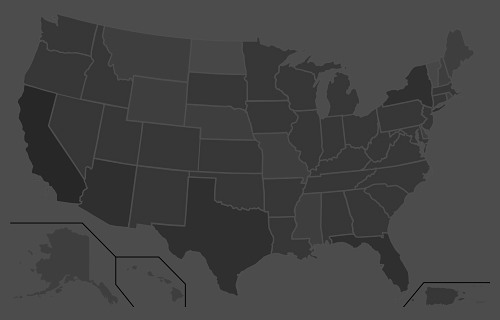“Our added winter moisture and active calling period led to a very long nesting and hatching season, starting in late April and extending into early summer, with chicks hatching as late as early July,” O’Dell said. “From a population standpoint, we are out of a deficit for the first time since 2001-2002. Quail are starting to pop up in places they haven’t been seen in a while.
“If you’ve never had the chance to experience what Arizona quail hunting built its name on, then this would be the year to get out and enjoy it.”
Meanwhile, hunters should note that the season for Mearns’ quail doesn’t begin until Dec. 4. It’s summer rainfall that plays a key role in nesting success and population numbers of this species. After a spotty and relatively weak monsoon across southern Arizona, these birds are likely to be abundant only in pockets that received sufficient precipitation this summer.
A valid Arizona hunting or combination hunt and fish license is required for all hunters 10 and older. Those hunters under 10 must either have a valid hunting or combination hunt and fish license, or be accompanied by an adult who possesses a valid hunting or combination hunt and fish license. Licenses can be purchased online or at license dealers statewide. A youth combination hunt and fish license (ages 10 to 17) is $5.
The general bag limit is 15 quail per day in the aggregate, of which no more than eight may be Mearns’ quail (when the Mearns’ season opens Dec. 4). The general possession limit is 45 quail in the aggregate after opening day, of which no more than 15 Gambel’s, scaled or California quail in the aggregate may be taken in any one day. After the opening of the Mearns’ season, the 45-quail possession limit may include 24 Mearns’ quail, of which no more than eight may be taken in any one day.
More quail-hunting information can be found on the department’s website at https://www.azgfd.com/Hunting/. Another resource for both new and experienced hunters alike is “An Introduction to Hunting Arizona’s Small Game.” Written by Randall D. Babb, the 196-page, full-color book covers where and how to hunt small game birds (like quail), squirrels, rabbits, ducks and geese. It also includes how to prepare and cook your harvest, with illustrations and recipes. The book can be ordered for $16.95 at www.azgfd.gov/publications.
Finally, hunters should check out O’Dell’s techniques for field-dressing quail at https://www.youtube.com/watch?v=3gRwZAcWzzk.
####
Publishers Notes: OUT OF STATE HUNTERS, FISHERMEN & OUTDOOR ENTHUSIASTS; Due to the Covid 19 pandemic, there could be limitations for OUT of STATE hunters, fishermen and other outdoor enthusiasts to include a 14-day quarantine requirement or negative COVID-19 testing alternative. Please check with the State's Department of Natural Resources BEFORE you travel or apply for the 2020 Fall Hunts.
Disclaimer: The views expressed on this site are that of the authors and not necessarily that of TBC Press
South Dakota Commission Amends Nest Predator Bounty Program
Submitted by: TBC Press
Posted on: 02/01/21
The Backcountry Press
The country's premier daily HUNTING, FISHING & OUTDOOR news in the USA and around the globe. Read whats happening in your neck of the woods & beyond.
© 2020 TBC Press - All Rights Reserved Website Design by:
News # 14178
“Each year, approximately 75 percent of duck and pheasant nests have been lost to predation in South Dakota. Intensive and ongoing predator removal efforts on lands containing quality habitat are important for increasing nest success at a localized level and present an excellent opportunity for an outdoor experience the entire family can enjoy,” stated GFP Commissioner Bob Whitmyre.
GFP will also enhance the ETHICS SD program to reach new audiences across South Dakota. ETHICS SD is a partnership between trapping organizations, GFP and 4H where youth learn trapping skills, fur handling techniques, and elements of wildlife management. The program has doubled in size reaching 110 new students in 11 counties in 2020.
“The key to ensuring our outdoor trapping traditions remain strong for future generations is educating and encouraging youth to participate in wildlife management,” said Robling. “We are excited to hear about the lasting memories these families make as they take to the field.”
The GFP Commission is allowing public comment on the amended program changes for the next 30 days and will vote on it at their March 4-5, 2021, meeting. To hear the discussion on this proposal, audio is available through South Dakota Public Broadcasting and on the GFP website under the meeting archive. Individuals can comment on this proposal by visiting gfp.sd.gov/forms/positions. Comments can also be mailed to 523 E. Capitol Ave., Pierre, SD 57501. To be included in the public record and to be considered by the Commission, comments must include a full name and city of residence and meet the submission deadline of 72 hours before the public hearing (not including the day of the public hearing).
Individuals are encouraged to share their trapping and outdoor memories by using #SDintheField on social media.
GFP has operated the Nest Predator Bounty Program for the past two years (2019 and 2020) with different program details/parameters (i.e. amount paid per predator, duration of program, license requirements, etc.) each year. For more details, visit https://gfp.sd.gov/bounty-program/.
- Participants under the age of 18 and landowners harvesting nest predators from their own land are not required to have a license. All other participants are required to have a 2020 hunting, fishing or furbearer license.
- Participants must comply with South Dakota trapping and hunting rules and regulations, which can be found in the current hunting and trapping handbook or online at https://gfp.sd.gov/pages/regulations/.
####
Publishers Notes: Our country is still battling COVID-19. To avoid the spread of this virus and continue to enjoy outdoor activities, ALL outdoor enthusiasts (man, woman, child) should follow the guidelines set by nps.gov. These guidelines include; social distancing, the Leave No Trace principles, including pack-in and pack-out, to keep outdoor spaces safe and healthy.
The South Dakota Game, Fish and Parks (GFP) Commission recently amended a resolution to the Nest Predator Bounty Program for this year and next. The resolution indicates that the 2021 program will include a payment of $10/predator and a cap of $500,000. The amendment specifically modifies the dates of when the program will start and end in which the GFP Commission unanimously agreed to run the program from March 15 through July 1.
“The primary goal of the program is to enhance nest success for pheasants and ducks at localized levels by removing primary nest predators, like raccoons, striped skunks, opossums, red fox and badgers from the landscape,” said interim department secretary Kevin Robling. “Furthermore, this program is designed to increase youth and family participation in understanding and experiencing the tradition of trapping while enhancing our strong outdoor heritage.”
Last year, 16 percent of participants were 17 years-old or younger. These families and youth participating in the program made lasting memories while making a difference for managing wildlife in South Dakota. To encourage even greater participation in 2021, GFP will provide a weekly giveaway for all youth (17 years-old and younger) that participate in the program. The giveaway will consist of a GFP-sponsored trapping package that includes three live traps, knife, and the National Trappers Association Trapping Handbook.












